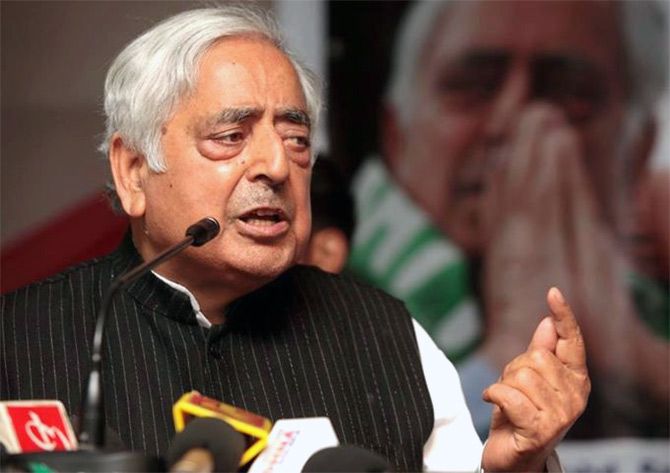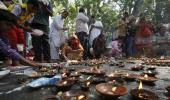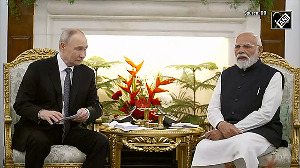'The ISI wanted to create internal disruption in the Valley by the killing of the security forces.'

Author and senior journalist Prem Shankar Jha has been following developments very closely in Jammu and Kashmir for a long time.
With The Kashmir Files having swept the box office and a reawakened interest in the plight of the Kashmiri Pandits, Jha offers his insights to Rediff.com Senior Contributor Rashme Sehgal into the tenure of the V P Singh government during which this exodus was triggered.
You were media adviser to the V P Singh government and have written many books on Kashmir. Do you think in retrospect that it was a good decision to have released Rubaiyya Sayeed in exchange for seven JKLF militants?
The Kashmir crisis imploded after that kidnapping and the Valley has been on the boil ever since.
I would like to clarify that V P Singh made Mufti Mohammed Sayeed home minister not because he needed his support, but because he wanted to undo the damage that had been done following the rigging of the elections in Kashmir in 1987.
Mufti was not a National Conference leader, but the tallest leader of the pro-India Kashmiri political formations at that time.
V P Singh believed Mufti would help ensure peace and justice in Kashmir. He was a good choice.
The ISI wanted to make him vulnerable, and they decided the way to get at him was by kidnapping his daughter.
The planning of that operation was not done by any local Kashmiri group.
It was an out and out ISI operation.
You will ask me how I am convinced about this. I am sorry I cannot talk about it.
All I can talk about it is from impressions, clear and unambiguous, following several interactions I have had with the senior leadership of the JKLF who told me that they were forced to conduct two to three actions, one of which was the kidnapping of Rubaiyya, the other was the killing of the HMT senior manager H L Khera and of the vice chancellor of Kashmir University Dr Mushir-ul Haq.
You are saying the JKLF was forced into doing the kidnapping?
The alternative was that they would be cut off completely. They had around 5,000 cadre in Pakistan who would stand isolated and vulnerable.
Are you saying the kidnapping took place because the JKLF was held hostage by the ISI?
Hostage is a strong word. Kashmir was being manipulated by Pakistan and this manipulation plan started in 1987.
Syed Salahuddin was briefly imprisoned after he took to the streets to protest the rigging of the 1987 elections.
The moment he was freed and his election agents were freed, they all jumped bail and crossed over to Pakistan where Salahuddin went on to become head of the Hizbul Mujahideen.
There was no Hizbul Mujahideen before that.
While (over the years) the JKLF went down in importance and Hizbul Mujahideen's importance went up because the JKLF had stopped cooperating with the ISI.

The situation in Kashmir has been going rapidly downhill since. The years that have followed have been tragic for the Valley.
It all goes back to 1984 with the hanging of (JKLF founder) Maqbool Bhat.
Several hundred Kashmiris belonging to the National Liberation Front, the armed wing of the JKLF under Maqbool Bhat, went across to Pakistan.
Not all the cadre, but a fairly large number did go and they conducted the first violent attacks in Kashmir.
The JKLF soon realised that the Pakistanis were not interested in helping them (in their dream of getting azaadi) if they did not say that Kashmir be made a part of Pakistan.
One of the founders of the JKLF, Hashim Qureshi, realised the ISI game plan and had to run for his life.
When he returned to Srinagar from Pakistan he wrote an article in Chattan, a local newspaper, warning the public that the trigger would always be with Pakistan as was the option to use the trigger.
My impression is they did not want to kill, but they received clear instructions from the ISI.
The ISI wanted to create internal disruption in the Valley by the killing of the security forces.
The BJP sadly do not know the difference between militants and the Hurriyat.
A total of 22,000 people were killed between 1990-1998 in Kashmir.
From these, 3,000 were killed in crossfire, 1,400 police and security forces were killed, between 4,000-5,000 militants were killed, over 4,000 members of the National Conference were killed and the remaining were Kashmiri Pandits and Kashmiri Muslims all killed at the hands of militants.
Would you say in retrospect that the situation could have been handled differently in order to have ensured that the Kashmiri Pandits did not leave the Valley in such large numbers?
Nothing could have prevented it as it was all planned by the ISI right from the start.
There were enough numbers of people to conduct (terrorist) operations.
In any case, by that time, most of the urban Kashmiri Pandits had at least one member of their family living in mainland India. Unlike the Kashmiri Muslims. And some of them had very good jobs.
With the eruption of violence, the better off Kashmiri Pandits left because they had places to go to.
Moving out, they then believed, was a temporary move and once violence ceased they would return.
It was the poorest Kashmiri Pandits who were forced to go and live in camps.

You mentioned in a recent interview that if Mufti Mohammed Sayeed had resigned as home minister, it would have sent out a completely different signal.
A political kidnapping of this kind had not happened in Kashmir before.
I remember I was in office when I learnt the kidnapping had taken place.
We did not have a clue why it happened.
The home minister was understandably upset, after all it was his daughter.
The V P Singh government was just six days old. A decision was taken (to release Dr Rubaiyya Sayeed) which in retrospect seems to have been the wrong one.
Looking back, if Mufti had resigned, it would have blown the ISI game plan.
She would have ceased to be a political pawn.
The question before the five JKLF Kashmiri boys who had kidnapped her was what would they kill her for? No political gain could have been made from it.
After the killing of the Khera and Dr Mushir-ul Haq, there were many more kidnappings.
They negotiated and got money and were let off.
In retrospect, one can say that would have been a better course of action.
V P Singh did not ask Mufti to resign as that would send out a message of weakness.
But the hope that he would be acceptable was completely destroyed (following the kidnapping).

You said the government at that time did not have a clue. Surely, they were being briefed about the involvement of the ISI and its Machiavellian gameplan for the Valley?
There was no forewarning from the IB (Intelligence Bureau) on this kidnapping.
As I mentioned, the V P Singh government was a few days old.
Not for one moment did they expect her (Dr Rubaiyya Sayeed) to be kidnapped.
The message sent out to Mufti Sayeed was that they had him by the neck.
A junoon had taken over the Kashmiri youth in their dream of azaadi.

Every Kashmiri politician or intellectual that George Fernandes as V P Singh's special envoy went to meet during Singh's tenure to find out what measures they believed should be taken to bring peace to the Valley were killed by militants. The ISI was determined to ensure there was no return of normalcy in the Valley.
That happened much later. The (Dr Rubaiyya Sayeed) kidnapping took place in (December) 1989. The government did receive plenty of warnings that something was cooking.
As I have said earlier, it started with the 1987 elections followed by the crossing over of Syed Salahuddin.
He certainly became the focus around which a concrete plan was drawn up to start a killing spree and put the blame on India's security forces. This was Operation Tupac.
Did then J&K governor Jagmohan play a key role in facilitating the exit of the Kashmiri Pandits from the Valley?
The Kashmiri Pandits did seek his help so they could receive State protection.
But it was not possible to provide every Pandit family with round the clock security protection. That was not feasible.
Feature Presentation: Aslam Hunani/Rediff.com










